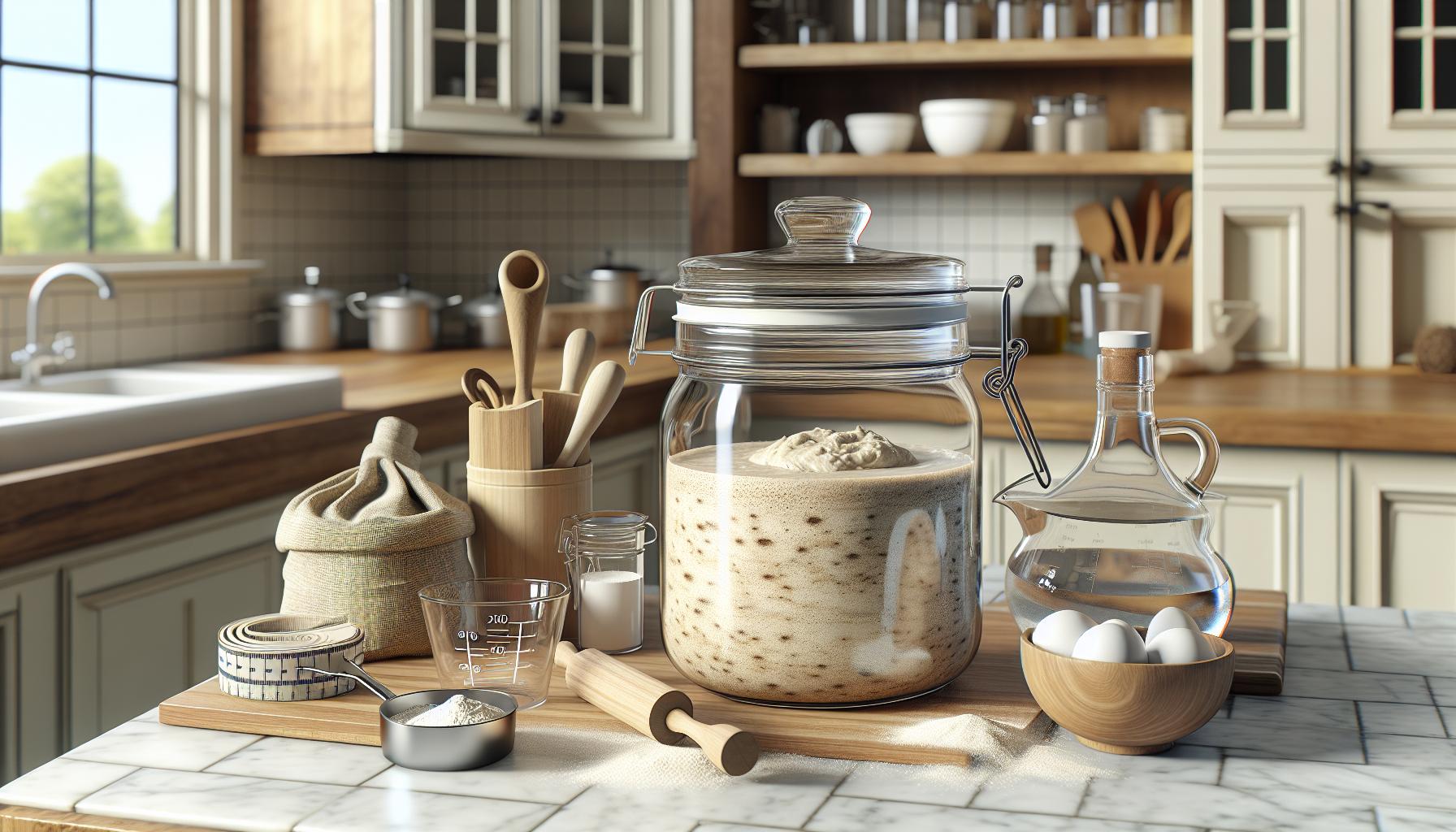Sourdough baking has taken the culinary world by storm, but what happens to the leftover starter? Instead of tossing that sourdough discard, I’ve discovered a treasure trove of healthy recipes that make the most of this often-overlooked ingredient. Not only does using discard reduce waste, but it also adds a delightful tang to various dishes.
Key Takeaways
- Understanding Sourdough Discard: Sourdough discard is the portion of starter removed during feeding, which can be repurposed into various nutritious recipes, reducing waste while enhancing flavor.
- Health Benefits: Sourdough discard is rich in vitamins, minerals, and probiotics that are beneficial for gut health, providing a nutritious boost to meals.
- Environmental Sustainability: Utilizing sourdough discard promotes a zero-waste lifestyle, significantly reducing food waste and encouraging conscious consumption in cooking practices.
- Versatile Recipe Options: Sourdough discard can be creatively used in a wide array of recipes, including pancakes, banana bread, pizza crusts, and even desserts, making cooking both fun and practical.
- Storage Tips: Proper storage of sourdough discard in airtight containers can prolong its freshness, with options to refrigerate for a week or freeze for several months.
- Easy Substitution: Incorporating sourdough discard in recipes typically requires minimal adjustments, enabling easy integration of this ingredient while retaining the desired taste and texture.
Sourdough Discard Healthy Recipes
Sourdough discard refers to the portion of sourdough starter removed during feeding. This process keeps the starter active and healthy. Tossing this flavorful discard seems wasteful, especially when it offers various culinary possibilities. Using sourdough discard adds depth and a tangy flavor to numerous recipes.
Sourdough discard contains beneficial bacteria and wild yeast, contributing to its unique taste profile. Instead of discarding this resource, I focus on incorporating it into dishes, enhancing nutrition and flavor. Sourdough discard can replace or complement ingredients in pancakes, waffles, muffins, and breads, promoting a zero-waste approach.
Utilizing sourdough discard contributes to a healthier lifestyle. This ingredient contains nutrients from flour and promotes gut health due to its fermentation process. By opting for sourdough discard in recipes, I embrace sustainability while enjoying delicious food options.
Many recipes require minimal adjustments when including sourdough discard. Typically, one-third to one-half of the total flour weight can be substituted with discard. This substitution not only helps reduce waste but also imparts a distinct flavor to the final product.
Benefits of Using Sourdough Discard

Utilizing sourdough discard offers numerous advantages for both health and the environment. It enhances recipes while promoting sustainability.
Nutritional Value
Sourdough discard is packed with nutrients. It contains vitamins, minerals, and probiotics beneficial for digestive health. By incorporating it into recipes, I enrich meals with essential nutrients. For example, the fermentation process increases the bioavailability of nutrients, making them easier for my body to absorb. Incorporating sourdough discard into different dishes provides dietary fiber, which supports gut health and aids digestion.
Environmental Impact
Using sourdough discard significantly reduces food waste. By repurposing what would otherwise be discarded, I contribute to a more sustainable kitchen. This practice decreases the environmental burden associated with food disposal. Moreover, utilizing sourdough discard promotes a zero-waste lifestyle, allowing me to enjoy delicious meals while minimizing my ecological footprint. Embracing this approach fosters a culture of conscious consumption, encouraging others to think about waste reduction in their cooking practices.
Healthy Recipe Ideas

Using sourdough discard opens up a world of delicious and nutritious recipes. Here are some options for breakfast, lunch, dinner, snacks, and desserts that make great use of leftover sourdough starter.
Breakfast Options
- Sourdough Pancakes: Combine 1 cup of sourdough discard with 1 cup of flour, 1 cup of milk, 1 egg, and a tablespoon of baking powder. Cook on a griddle for fluffy, tangy pancakes. Customize with berries or nuts for added nutrition.
- Sourdough Banana Bread: Mix 1 cup of sourdough discard with 2 ripe mashed bananas, 1/3 cup of oil, 1/2 cup of sugar, 1 egg, and 1 teaspoon of baking soda. Bake at 350°F for 50-60 minutes. This recipe creates a moist bread while minimizing food waste.
- Overnight Sourdough Oats: Combine 1/2 cup of sourdough discard, 1 cup of rolled oats, 1 cup of milk, and your favorite sweeteners and spices in a jar. Let it sit overnight in the fridge. In the morning, enjoy a nutrient-packed breakfast.
Lunch and Dinner Recipes
- Sourdough Pizza Crust: Blend 1 ½ cups of sourdough discard with 1 ½ cups of flour, 1 teaspoon of salt, and enough water to form a dough. Allow it to rise for 30 minutes, then shape and top with sauce, cheese, and veggies. This creates a tasty, homemade pizza.
- Sourdough Flatbreads: Mix 1 cup of sourdough discard with 1 cup of flour and a pinch of salt. Roll into thin rounds and cook on a skillet for quick, healthy flatbreads. Serve with hummus or yogurt for a balanced meal.
- Sourdough Vegetable Fritters: Combine 1 cup of sourdough discard, 1 cup of grated vegetables (like zucchini or carrots), and 1 egg. Fry in olive oil until golden brown. These fritters make a flavorful side dish or main course.
- Sourdough Crackers: Mix 1 cup of sourdough discard with 1/3 cup of olive oil, 1 cup of flour, and seasonings. Roll thin and bake at 350°F for 15-20 minutes. These crispy snacks are perfect for dipping or topping with cheese.
- Sourdough Muffins: Combine 1 cup of sourdough discard with 1 ½ cups of flour, 1 cup of mashed fruit (like applesauce or pumpkin), and 1 egg. Bake at 350°F for 20-25 minutes. This recipe yields soft, nutritious muffins.
- Sourdough Chocolate Cake: Blend 1 cup of sourdough discard with 1 ½ cups of flour, 1 cup of sugar, 1/2 cup of cocoa powder, 1 cup of oil, and 1 cup of water or milk. Bake at 350°F for 30-35 minutes. This cake’s unique flavor profile makes it a hit at any gathering.
Tips for Storing Sourdough Discard

Store sourdough discard in the refrigerator for up to one week. Use an airtight container to keep it fresh and minimize odors.
Substitute glass or plastic containers instead of metal to avoid reactions with the acidic nature of sourdough. Label the container with the date of storage to track freshness.
Freeze sourdough discard for longer storage periods. Portion it into smaller containers or ice cube trays, allowing for easy use in recipes. Frozen sourdough discard lasts for several months while retaining its quality.
Thaw frozen discard in the refrigerator overnight or at room temperature for a few hours. Avoid microwaving, as this may alter the texture and flavor.
Consider feeding sourdough discard before use to revive its viability. Adding equal parts flour and water enhances its flavor and for leavening potential in recipes.
Monitor for signs of spoilage, such as off odors or discoloration. Discard any sourdough starter that shows mold or an unusual smell to ensure food safety.
Positive Impact
Embracing sourdough discard opens up a world of culinary creativity while promoting a healthier lifestyle. I love how this often-overlooked ingredient can transform everyday meals into nutritious delights. By incorporating sourdough discard into my cooking, I’ve not only reduced food waste but also enhanced the flavor and texture of my dishes.
Whether it’s pancakes for breakfast or a savory flatbread for dinner, the possibilities are endless. It’s rewarding to know that I’m making a positive impact on both my health and the environment. I encourage you to experiment with these recipes and discover the delicious benefits of sourdough discard in your own kitchen. Happy baking!



